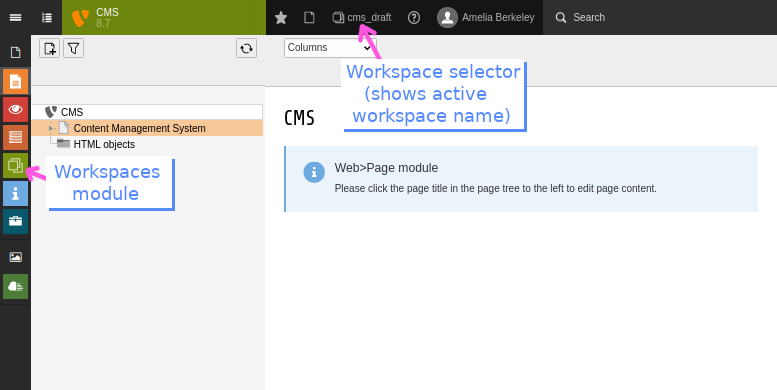What is a workspace?
Within CMS, a workspace is a place where you author content of a Web page before it is published (made visible to visitors). It embeds a workflow process where authors draft content and publishers publish the content to the Web.
Using workspaces, you cannot break a site (unless you publish the change). At any time you can Discard a draft version, which is to revert to the version of the page content that visitors see.
A workspace uses the concept of versioning to make this happen.
Versioning
Versioning means each revision of a page is identified by a version number. In terms of books, think "third edition," for example. One or more authors and reviewers work on the content until they are ready to publish the next edition, or version. The old content is kept on the live site seen by visitors until the new version is published, or on bookstore shelves until the new version is published and shipped to the stores. Publication of a new edition (or version) doesn't mean all of the old revisions disappear from existence, they are simply taken off the shelf and not displayed to visitors anymore.
This also means that you could delete a page in a site and as long as you don't publish that change, all you have to do is cancel the deletes (this is called Discard) and visitors won't know anything happened at all. Or you could author a large block of new content and without publishing it, visitors won't know you authored it.
NDSU workspaces
At NDSU, your department content is located in a workspace labeled yourdepartment_draft. Why "_draft?" It's because we call these unpublished versions "drafts." When you edit a page in CMS, a copy is made and you work on the draft copy, never the live version.
It's not as complicated this sounds. All of the versioning and draft copies are automatically created and managed by CMS.
Evidence of workspace in backend
If you have access to more than one workspace, the Workspace selector is visible at the top of the TYPO3 interface.
The active Workspace name is also displayed after your username at the top of the screen.

Multiple "sites" per workspace
A workspace can contain more than one NDSU department/organization.
This option is commonly chosen when
- A department has an NDSU top-level (e.g. www.ndsu.edu/departmentname) Web presence for a department-sponsored program
- The workspace primary manager approves the addition of another top-level presence to the workspace and accepts the same responsibility for those page(s) as for the primary department
- The same set of people will be have access to create content in all of the pages in the workspace. Granular assignment of permissions to each top-level presence is not available; if that is desired, each Web presence should be in its own workspace
For example, if the College of Engineering and Architecture used CMS for the main COA site (hypothetically www.ndsu.edu/cea) there would be a workspace called cea_draft for the college. If the college wanted the same team of people to manage and maintain all of the academic department pages for the college, and wanted those pages to be top-level directories under www.ndsu.edu, they could request for other departments pages to be added to the workspace. Upon approval from the cea_draft workspace primary manager, the cea_workspace would contain www.ndsu.edu/coa, Mechanical Engineering www.ndsu.edu/me, Industrial Engineering www.ndsu.edu/ime, Electrical Engineering www.ndsu.edu/ece, etc.
Note that this arrangement is for example only, and is not intended to suggest that a college must have all of its academic department pages within the same workspace.


